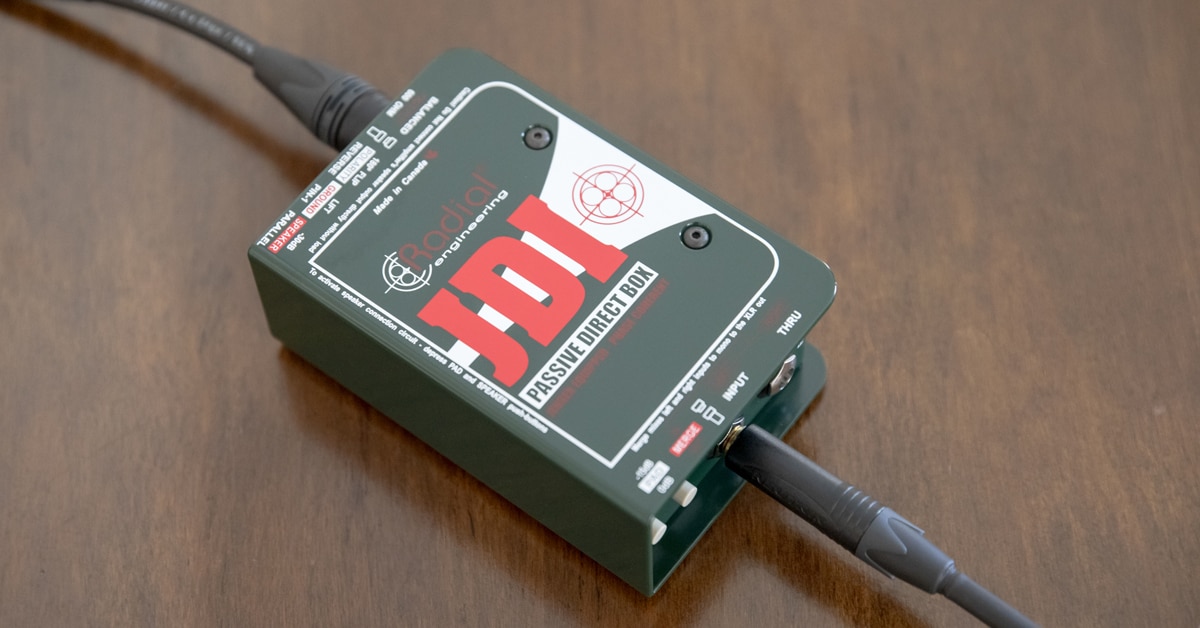Need help understanding the differences between active and passive DIs, how they work, and how to harness them onstage and in the studio for better sound? You've come to the right place.
Table of Contents
What is a DI and Why You Need One
A Short History of the Direct Box (DI)
What is an Active DI?
What is a Passive DI?
Specialty DIs
Connecting Mobile Devices to a Mono Mixer
Choosing a DI
Passive Uses
Features to Look For
Tricks of the trade
Glossary
What is a DI and Why You Need One
Contrary to popular belief, a direct box is not a device that comes right out and says what it really thinks of your playing. Also known as a “DI” (for direct inject or direct input), its main function is to convert the unbalanced high-impedance output of an instrument to balanced low impedance, which in turn allows longer cable runs without adding noise. At their most basic, DIs are equipped with at least one input and two outputs; one being a thru-put for an instrument amplifier, and the other for input to a PA system. The output of a DI is mic level, which allows it to be connected to the microphone inputs of a mixer. Another useful function of the direct box is its ability to eliminate AC hum that stems from ground loops. Direct boxes divide themselves into two families, Clan Active and Clan Passive (which cannot die).
A Short History of the Direct Box (DI)
Back in the golden age of music, men and Elvises roamed the midrange together in peace and all DIs were passive. First appearing in the 1970s, as venues became larger and touring equipment became more powerful and complex, the direct box served to isolate a musician’s stage amplifier from the PA system (eliminating hum). They allowed longer cable runs by lowering impedance and balancing the signal. Back then, a direct box was basically “a transformer in a can” and mainly built on the fly. The active direct box didn’t appear until the ’80s, after it was noticed that the passive DIs were having a negative effect on the sound of certain instruments, most notably Fender basses equipped with single-coil pickups. Active DIs operate either using a battery or phantom power. Both active and passive types are in use today, and each has its advantages depending on the application.
What is an Active DI?
Active direct boxes are in fact preamplifiers, whose primary function is to provide higher input impedance than that of a transformer to drive instruments with low-level signals. For example, if you were using a passive DI to send an old Fender bass to the console, its single-coil pickup had to drive amp, transformer, mic-splitter transformer, and a few hundred feet of cable. The result would be a lack of punch and clarity due to the excessive loading of the pickup. This is not to say that all passive DIs sound bad. Remember, application plays a large role. Another reason for sound quality issues with passive DIs in the past was that cheap transformers were being used to keep prices down. Unfortunately, poorly designed transformers can cause ringing and smearing of the upper frequencies, or a reduction of sound quality in general. Active DIs were created as a means of improving sound quality while keeping costs down. They did so by providing enough gain to drive the aforementioned Fender bass without adversely loading the instrument’s pickup. The tradeoff with active devices is the loss of ground isolation.
Active DIs can take their power from batteries, which is less desirable to professional touring FOH (Front of House) engineers, or phantom power coming off the mixer (more desirable). Active DIs, being much like preamps, also have features such as pads, ground-lift switches, high-pass-filters, polarity reverse, and equalization switches.
What is a Passive DI?
As we stated earlier, a direct box is basically a transformer. It acts as a bridge between input and output by virtue of electromagnetic induction. In essence the signal is passed through a shared magnetic field. Since there’s no hard wiring, the signal is electronically isolated from input to output. As a result, 60-cycle hum from ground loops and DC noise are eliminated. The word “passive” means that the unit does not require power in order to operate. Another advantage of transformers is that they don’t distort the way active circuits do when they are driven into overload. With active circuits, it’s all or nothing. Once overdriven, they abruptly go from clean to completely distorted and harsh, whereas transformers saturate, thus presenting a smooth transition that mimics the behavior of a limiter. On the downside, transformers aren’t particularly good at handling low-output instruments, such as old electric guitars, basses, and vintage keyboards, since there is no power to drive a weak signal. On the upside, along with hum-eliminating abilities, passive DIs are good at handling high-output instruments (anything with a battery-powered preamp, for example).
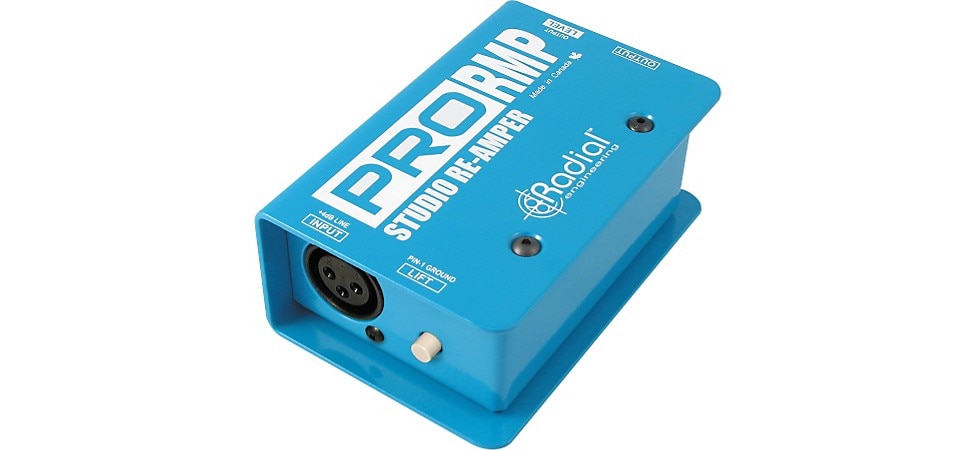
The Radial Engineering ProRMP Passive DI is a great tool for re-amping dry guitar signals through amps and effects pedals.
Specialty DIs
Some specialty active DIs have added features such as the Radial Engineering J48, which has a mono summing switch (that may not sound like a big deal, but it can really come in handy when you have limited console inputs and a rack of stereo keyboards shows up at the gig).
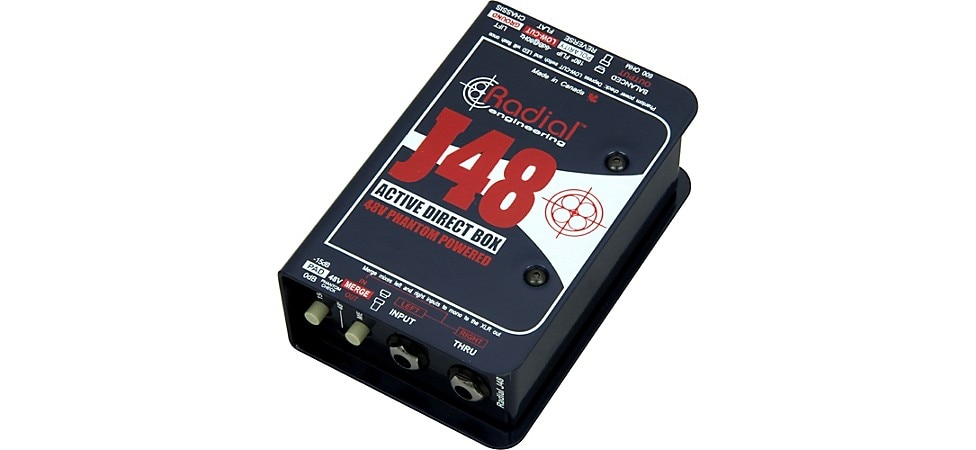
The rock-solid Radial Engineering J48 Active Direct Box allows summing two signals into mono, has a 15dB pad, and can easily handle transient signal peaks.
A passive mic splitter, as its name implies, is a DI that splits a signal from a low-impedance source, such as a microphone, to two outputs. This enables you to feed two preamps from one source. Applications include onstage monitoring for musicians, live recording, videotaping and/or recording lectures or religious services, or simply for driving long microphone lines feeding an unbalanced input.
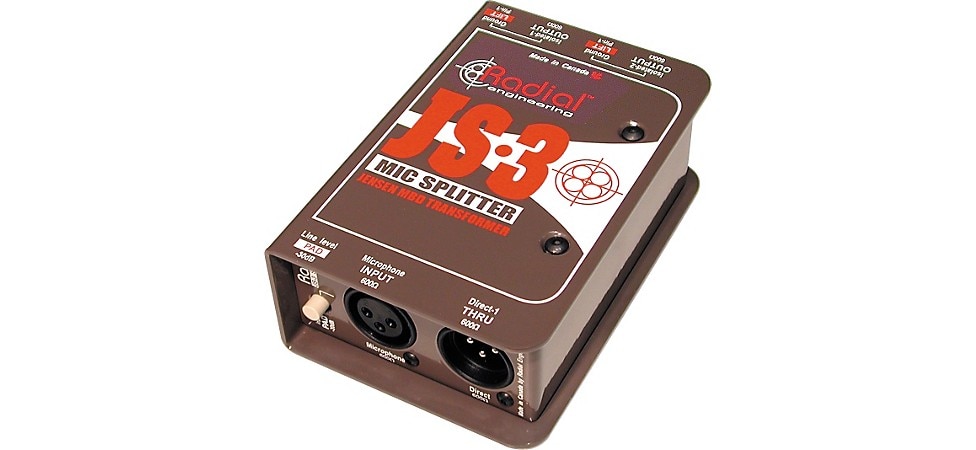
The versatile Radial Engineering JS3 Mic Splitter allows routing of XLR signals to deal with challenging connection scenarios while adding a ground-lift function to keep hum at bay.
An Isolation Transformer is a DI that uses a floating transformer-isolated output (see Isolated Line Output below) to eliminate ground loops between equipment connected with unbalanced lines. The floating transformer provides the noise-reduction benefits of balanced lines.
Applications include connecting the unbalanced output of a mixer that must drive long unbalanced cables to power amplifier inputs, and connecting line-level sound modules and samplers, etc. to live sound or recording mixers.
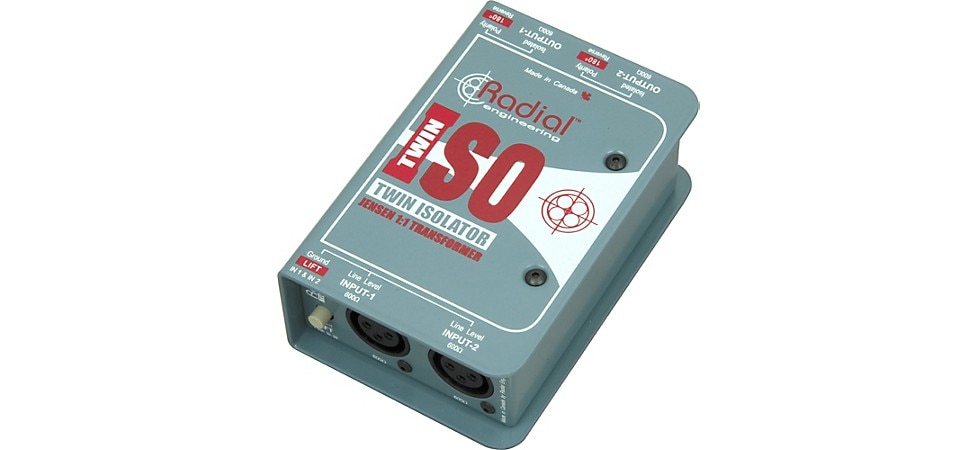
The Radial Engineering TWIN ISO is a powerful tool for eliminating hum and other noise while producing tightly focused bass sound.
Connecting Mobile Devices to a Mono Mixer
Using tablets, smart phones, iPods, and laptops for backing tracks has become increasingly popular for live performance. There are DIs that are built specifically to address the problems that can occur when connecting an unbalanced stereo source to a mono mixer’s input channels. These problems include noise, signal loss, and permanent damage from phantom power. To run mono (especially for long distances), you need a DI that will sum the stereo outputs to balanced mono and provide transformer isolation to protect your equipment from damage by phantom power. One such device that handles all of this beautifully is the Radial ProAV1, a passive direct box with 1/4", RCA, and 1/8" stereo connectors for instruments, tablets, iPods, and computers that are summed to mono. Never, we repeat, never try to combine two signals into one with a “Y” cable or use a single mono cable. Here’s why: Outputs are low impedance and always must be connected to a high impedance input. If you tie the two outputs together (with a “Y” cable or mono cable), each output will try to drive the other, which can force them beyond the safe current limit and possibly into short circuit. At minimum, you will experience a severe loss of signal. Worst case; you can damage your mobile device or laptop.
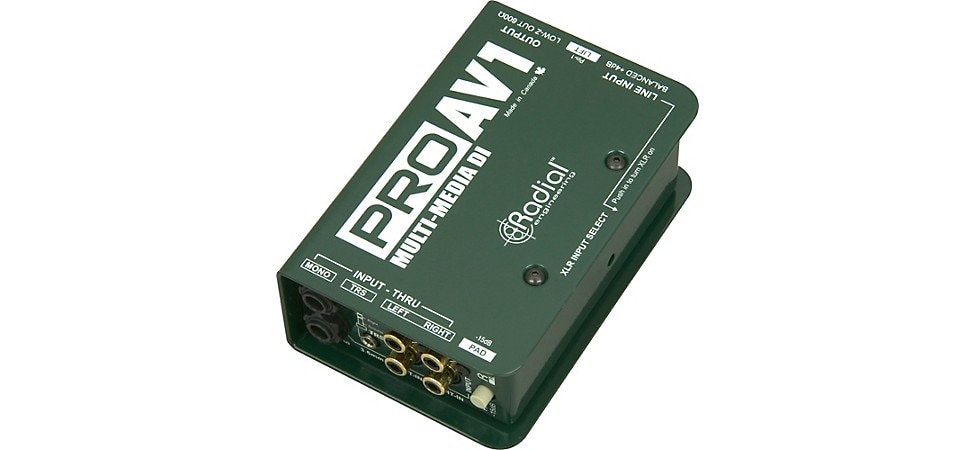
The Radial Engineering ProAV1 offers a Swiss Army Knife-like array of connectors for safely integrating consumer electronics and mobile devices with pro audio sound systems and recording gear.
Choosing a DI
Rule One
Choose a DI for the Sound you Like!
Like preamps or anything else that makes a sound, when it comes to choosing a DI, there are no hard and fast rules. Just as certain combinations of mic and preamp offer different sound qualities (not good or bad, just different), the same is true of DIs. In general, a passive DI will offer a “rounder” tone, while an active DI will provide more high-frequency content—much like the sonic distinction between tube and solid-state preamp design. We also recommend getting on the online audio gear forums to see what live sound and studio professionals are using. Another good source of information are the customer reviews of DIs posted on the Musician’s Friend website.
The law of opposites
In general, passive DIs are the choice for active sources and active DIs are preferred for passive sources. There are some exceptions to the rule. Some active sources can work very well with active DIs, particularly those designed with higher voltage-handling ability. There are also DIs that can operate as either active or passive, which is quite a handy thing for the studio or live sound pro who may not know what instruments will be showing up on any given day.
Active uses and things to consider
For direct recording in the studio, you’ll most likely want the sound of an active DI. Today, there are both tube and solid-state active direct boxes designed for studio use. Basically any instruments that do not have a form of internal power are suitable fare for an active DI. Examples would be acoustic instruments with piezoelectric pickups, classic basses, and old keyboards such as the Wurlitzer and Fender Rhodes electric pianos.
For acoustic-electric guitars and electric basses, active DIs can add high-frequency brilliance, which is certainly a plus for slap-style bass playing and bringing out attack information to aid tonal definition. However, the dramatic transients produced by aggressive rhythm guitar playing and “slapping” and “popping” on bass may cause an active DI to distort. If you’re using a high-output acoustic-electric or bass, look for a DI with the ability to handle high voltages such as the Radial J48 mentioned above.
If you’re playing a classic bass and wondering, where’s the beef? then an active DI is the answer. Today, there are active direct boxes that are specifically made with bass in mind such as the A Designs REDDI and Summit TD100. (They all work extremely well on guitars, synths, and electric pianos too.) There are also units that straddle the DI and preamp categories designed specifically for electric and acoustic guitars.
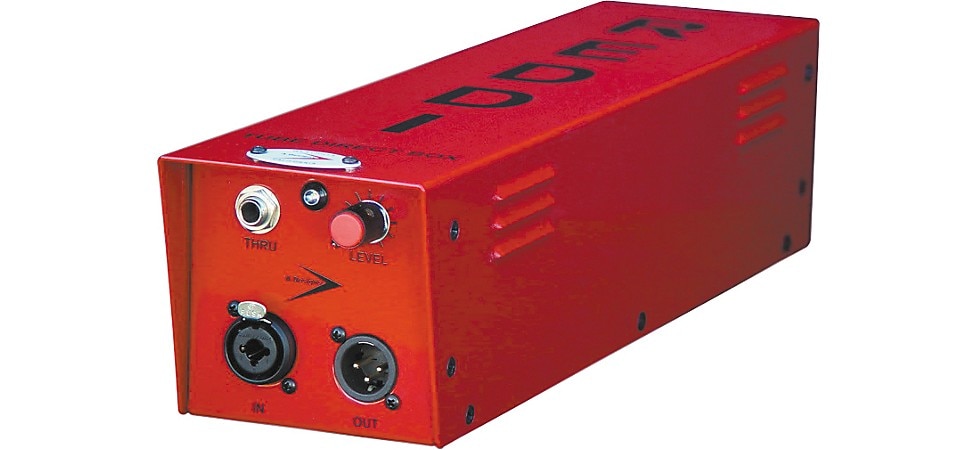
The REDDI Tube Direct Box from A Designs captures the output of basses, guitars and synths with warm, trasparent sound based on the iconic Ampeg B15 amp.
Some advice for bands setting up a PA system for gigging and aspiring FOH engineers: Certain active DIs are AC powered. Not a problem in the studio, but it might make them a little complicated for live performance use since you’ll have to make sure there’s AC power near the stage setup. Also, plugging an active DI into a nearby wall or power source can cause ground loops. Most, if not all, active DIs have a ground lift switch to solve that problem; however, you might find yourself switching between loud noise and less noise. From an FOH engineer’s point of view, a DI that uses phantom power might be a better choice.
As with preamps, look for an active DI with high-quality transformers (the same holds true for passive DIs) and a wide dynamic range. In live performance a wide-bandwidth DI will preserve the harmonic content of your instrument that lives above 20kHz. Along with enhanced sound quality, there is acoustic information in the upper frequency range that is a component of your instrument’s attack. And, as we stated earlier, poorly designed transformers can wreak havoc on the upper frequencies. The benefit of quality transformers and wide bandwidth is better definition and spatial localization, which allows your instrument to carve out its space in the mix.
Passive Uses
If you’re using an instrument with a built-in battery-powered preamp, such as an acoustic-electric guitar or bass, a passive DI will do the trick. Also, modern electronic keyboards and CD players are quite capable of producing output levels sufficient to overdrive an active DI. As we mentioned earlier, there are active DIs that can handle the high voltage requirements of these instruments and devices; however, a passive DI with a quality transformer is less expensive and won’t require batteries or an AC line, or take up a phantom-powered input in your console.
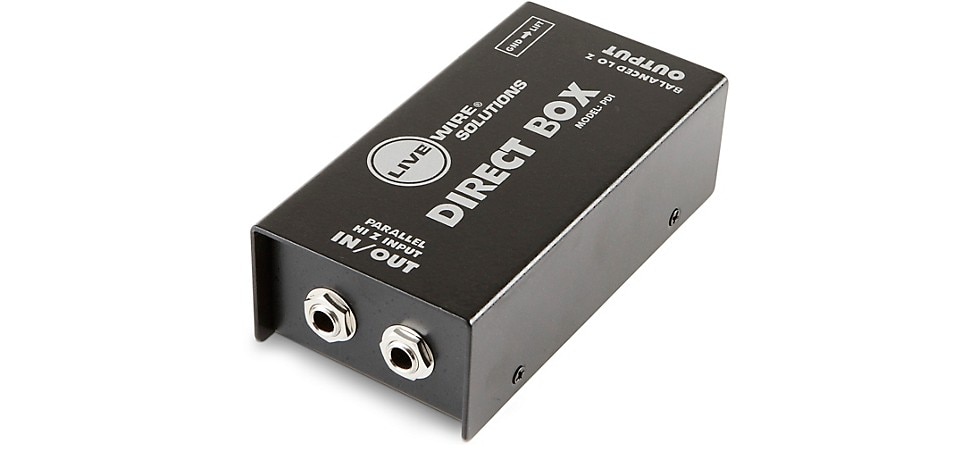
The Livewire PDI Double-Shielded Heavy-Duty Passive Direct Box converts line- or instrument-level signals to low-impedence balanced output.
For noise-related problem solving in live performances when there’s little time to troubleshoot noise from ground loops, etc., it’s good to have a few passive DIs on hand.
TIP: If you’re using a passive DI to send an output from an electric guitar amplifier to a console, do not sit the DI on top of your amp! The magnetic fields produced by the amp’s power transformers will defeat the DI’ s electronic isolation properties by interfering with its transformer. Noise and possible phase and frequency shift will be the result.
Features to Look For
At its most basic, a passive DI only requires an instrument input, balanced XLR output, and a ground lift switch (and a good transformer, of course). Here are some other features that may makes sense depending on your applications:
Pad — attenuates (reduces) the voltage or power level of a signal by a fixed amount, thus allowing very hot signals (such as that of a CD player) to be connected without overload, and balanced for long cable runs.
Thru-put — allows you to connect to an instrument amplifier along with the console.
Polarity reverse — used when combining sounds that may be out of phase.
Ground-lift — a switch found on DIs as well as many other pro audio products that separates the signal ground from the unit’s chassis ground. For example, when a ground path is made at the input side of the DI (from a keyboard for example), the ground-lift switch disconnects the ground path at the output (XLR) side.
Isolated line outputs — without going into too much technical detail, this is a floating-transformer-isolated feed. “Floating” means that the output is not connected to ground or another output, which provides maximum electrical isolation. The transformer-isolated feed provides common-mode noise rejection by fooling the circuit into thinking that it’s balanced.
Tricks of the trade
As any experienced FOH engineer will tell you, the fastest and easiest way to eliminate ground loop hum is to put a transformer in-between the offending units. Passive DIs such as the Whirlwind IMP-2 are quite affordable and do the job more than adequately.
A common use of the DI for an impressive sound in the studio is to combine a miked signal and a DI signal into two channels and blend them. The trick is to use phase reverse on the DI. If your DI or console does not have a phase reversal switch, you can wire an XLR cable to be out of phase. (Just swap pins 2 and 3 on one end of the cable and put some red tape on it so you don’t use it elsewhere.) If you’re recording to a DAW, just invert one of the channels (you can find this command in the Audio menu of most DAW software).
If you’re using an unbalanced line-out from your console to feed a house speaker system and experience loud 60-cycle hum, put a passive DI with isolated outputs (floating transformer) and a ground-lift switch in-between your console’s unbalanced output cable and the house system’s input cable. If you still hear noise, flipping the ground-lift switch should solve the problem.
After reading this guide if you’re still not sure which DI makes sense for your application, we invite you to call one of our friendly Gear Heads.
Glossary
AC (60 cycle) hum: In “household” electricity, the current flow reverses direction alternately as a function of time. In the United States, current changes direction at a rate of 60 times per second (60Hz). This oscillation produces an audible tone that is measured in Hertz. The sound often has harmonic content at multiples of 60Hz, with the most objectionable being at 120Hz and 180Hz. (see ground loop)
Active: In electronics, the term active has two definitions. One indicates that an active device is a source of electric power, such as a battery or generator. The other definition refers to components that can increase gain or the power of a signal by drawing on a power source. Commonly, when speaking of devices such as PA speakers or studio monitors, the word “active” means powered, whereas passive means un-powered.
Balanced/Unbalanced: A method of wiring audio cables that serves to eliminate noise by virtue of common-mode rejection. The balanced cable consists of two twisted wires and a shield. One wire is considered positive with respect to ground, the other negative, and the shield, which carries no signal, is an outer wrapping of conductive material that is grounded at both ends. The signal is transmitted over one wire and received back on the other, while the shield rejects noise from electrostatic fields and magnetic interference. In a properly balanced cable, impedance is equal on both lines relative to ground.
This guarantees that noise is picked up equally on both wires. The balanced input of a preamp for example, only amplifies the difference between the lines, thus eliminating the noise that is common to both. In an unbalanced cable, there is only one wire that carries the positive signal, while the negative signal is carried on the shield. Any noise induced into the cable will make its way into the audio signal.
Clipping: When the output voltage of an amplifier exceeds the limit of the power supply, the top of the output waveform is flattened. On the oscilloscope, the waveform looks as though its top is cut or clipped. A clipped waveform produces extreme harmonic distortion comprising unpleasant-sounding, odd-ordered harmonics.
Common-Mode Rejection Ratio (CMRR): In long cable runs, noise becomes an issue. Cables can pick up radio frequencies (RF) and other interference, which is why balanced cables are used for their noise-canceling ability. CMRR defines to what degree signals are canceled at the input of a balanced system.
Frequency Range: As it says, the actual range or span of frequencies from low to high that a device can pass or reproduce.
DC (Direct Current): Functionally the opposite of alternating current (AC), DC does not change directions. While most components within an electronic device are DC powered, DC is not optimal for audio signals, particularly those traveling to speakers, since DC produces no sound and uses a great deal more power.
Dynamic Range: In an audio device such as a preamp, dynamic range is a measurement taken from the ratio of the loudest undistorted signal (output voltage) to that of the quietest signal (noise floor) expressed in decibels (dB).
Electromagnetic Induction (or Inductive Coupling): Refers to the transfer of a signal from one component to another through a shared magnetic field. A change in current flow through one induces current flow in the other. These components can be contained in a single unit, such as the primary and secondary sides of a transformer.
Equalization (Equalizer): A class of electronic filters in acoustic systems that either amplify (boost) or attenuate (cut, reduce) selected frequencies (frequency-dependent amplification). Equalization is the act of modifying the frequency response of a signal.
Floating: A term used to describe a device or signal that is not grounded (“referenced to ground” as the electro-geeks like to say) or referenced to any other output. A microphone would be an example of a floating device since it has no reference to ground. Typically, floating outputs are fully isolated.
FOH (Front-of-House): The mixing position for live shows, which is usually opposite the stage in a concert hall, club, auditorium, or theater, etc. Since some venues have a sound booth setup that is either in the back or on the side, the term FOH refers to the location of the main mixing console wherever it may be.
Frequency: The number of complete cycles of a waveform in a given amount of time. Frequency is expressed in Hertz (Hz). One Hertz equals one cycle per second. As the number of cycles per second increases, so does pitch.
Gain: The amount of amplification (voltage, current, or power) of an audio signal, usually expressed in decibels (dB).
Ground: In an electronic circuit, ground is the common reference point or return path. Ground is also the point of zero voltage potential. In electronics, variance in potential causes electrons to flow from the higher potential to the lower. Grounding is a safety feature in terms of preventing electrical shock, as well as a means of preventing noise in interconnected audio systems and circuits.
Ground Lift: This is a means of removing AC hum caused by the presence of a ground loop in an interconnected audio system (see ground loop). The ground lift can take the form of a switch, in-line adapter, or transformer, which disconnects (lifts) one or more grounds in the system. Under no circumstances should you remove the ground pin of an AC line adapter, unless you want to become part of the ground loop, which can result in current passing from one of your hands to the other via your heart.
Ground Loop: This is the most common source of noise in electronic systems. When interconnecting electronic equipment, each component has it’s own internal ground, usually known as the audio signal ground. Connecting two (or more) devices can tie their signal grounds together via the cables. When the units are also tied together in another place, either by a line cord or the metal rails of a rack, current can flow in a closed loop from one unit’s ground to the other’s and back again. Noise or hum (see AC/60-cycle hum) occurs when this current flows through the unit’s audio signal.
Harmonics: A series of musical tones whose frequency is the multiple of a fundamental tone. Also referred to as overtones and partials.
High-Pass Filter: An electronic circuit that allows all frequencies above a fixed frequency (not zero) up to infinite frequency. High pass filters are useful for eliminating low-frequency rumble.
Impedance: A combination of factors that restrict current flow in an AC electrical circuit. Similar in concept to resistance, impedance has two components: resistance and reactance. Reactance also has two components, a “real” part (resistive) and an “imaginary” part, which is resistance induced by phase shift (e.g., the time it takes for other components such as inductors and capacitors to charge and discharge).
Limiter: Basically like a compressor, except that it does not allow the signal to go above the setting of the threshold. For example, if the limiter’s threshold (level at which the limiter will act on the signal) is set to –20dB, once the signal level reaches –20dB and beyond, the output level remains at –20dB. Limiters are used to prevent signals from clipping or overloading speakers, recorders, and power amplifiers, etc.
Loading (Load): In electronics, a load consumes energy to do some form of work. Any component or device that is connected to a source and draws current from it is considered a load. Loading is an effect that is a function of the load’s impedance. For example, if a load has high impedance (resistant to current flow), it will draw a small amount of current from the source, thus the load is small (light loading). Conversely, a small amount of load impedance will draw higher load current from the source (heavy loading).
Mono: Short for monophonic or monaural. A system that takes one or more sound sources and either records, reproduces, or transmits them via a single channel.
Pad (or Attenuator Pad): A passive network containing resistors connected in series that reduces (attenuates) the voltage (or power) level of an input signal. Pads can be used to reduce the level of a unit operating at +4dBu so that it can be connected to a unit operating at -10dBu without overloading it. Or, if a signal from a high-output microphone in front of a loud source causes a mic preamp to clip (even with the gain turned all the way down), a pad will allow the mic preamp to handle the signal without distortion.
Passive: In common usage, passive simply means that the unit does not require power in order to operate or, in the case of a monitor speaker, relies on an external power source to operate. On the component level, a passive device is one that does not add power to the signal it’s acting on; rather it draws its operating energy from the signal passing through it. Examples would be resistors, inductors, and capacitors.
Phantom Power: In conventional DC-polarized condenser mics, phantom power supplies the voltage required to polarize the mic’s transducer element (capsule), using the same two lines as the balanced audio path. It is called "phantom" powering because the supply voltage is effectively invisible to any balanced microphone. The Neumann Microphone Company developed phantom power in 1966.
Polarity: What we call positive and negative electrical potential with respect to a referenced potential. Polarity is often confused with phase reversal. Phase is a function of time; polarity is not. Often in audio engineering we say a signal is out of phase, when in reality we mean its polarity is inverted.
Phase: A particular value of time for any periodic or cyclic function, and refers to what fraction of the cycle the signal has advanced to.
Phase shift: An angular relationship between two waves, whereby the fraction of a complete cycle is measured from a specified reference point and expressed as an angle.
Preamplifier: The first amplifier in the chain, the preamplifier takes a low-level signal, such as from a guitar pickup, mic, or turntable and amplifies it. Technically speaking, the preamp provides significant voltage gain and small current gain, which makes a preamp good for recording applications. A power amplifier must follow in order for current to be amplified enough to power loudspeakers.
Saturation: The state when a material cannot absorb a stronger magnetic field, such that by introducing a greater magnetization force, no significant change on a magnetic field’s ability to exert a force on a moving charge occurs. In recording, tape saturation is the point at which magnetic tape has reached its maximum ability to accept signals, beyond which distortion occurs. As much as tape saturation is a thing to be avoided, it can be used as a creative tool. When program material is recorded at levels somewhat above 0dB, distortion is being added gradually, which has a pleasing effect. The upper frequencies become gradually compressed as tape is saturated, which also is more natural and pleasing to our ears.
Single-coil: This refers to the design of the magnetic pickups found on musical instruments such as electric guitar and bass. As the name implies, it employs one coil of wire wrapped around a magnet, whose job it is to convert string vibrations into an electrical signal by virtue of the string’s interaction with the magnetic field created by the magnet and coil. Single-coil pickups are passive, therefore they do not produce a high output and are more susceptible to noise.
Transformer: A passive component comprising two or more magnetically coupled coils or windings (usually wound around magnets) that use electromagnetic induction to increase or decrease voltage and current. Each coil or inductor shares a magnetic path. The more closely they are coupled magnetically, the more efficient they become. (see electromagnetic induction)
XLR: The original model number for 3-pin circular connectors invented by Canon, which has now become a generic term. XLR connectors are used to make balanced cables, such as those used for connecting microphones to preamps.





































































































































